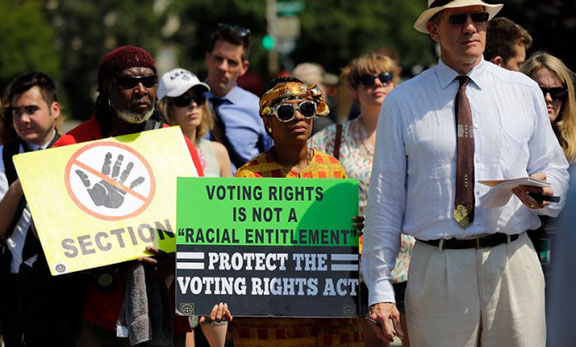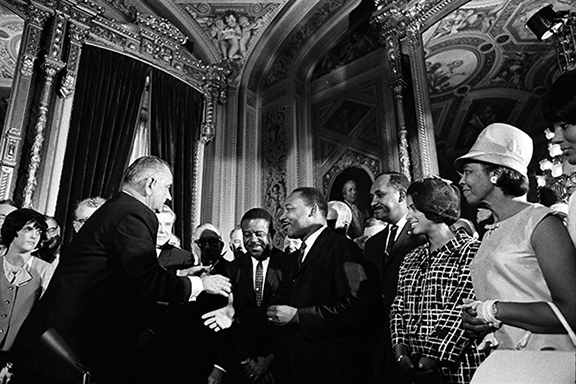by Malik Miah
July 1, 2013
By a narrow majority, 5-4, the US Supreme Court overturned the crucial enforcement provisions of historic 1965 Voting Rights Act. The ruling issued on June 25 is a major defeat for not only voting rights but civil rights.
Some have argued that it is not as bad as civil rights leaders proclaim — only a setback. But only those unfamiliar with grim realities of US history could make such an argument. What’s been won in the past has several times been reversed or so eroded it lost its effectiveness (more on that later).
The government of Texas, however, understood its significance when it stated after the court decision that it would immediately implement voter identification and redistricting plans that the Justice Department stopped last year.

Protestors gather outside of the Supreme Court following the announcement of the decision.
1965 historic law
The voting rights law for 48 years was a high wall that the former supporters of segregation, mainly in the southern states, had to climb before changes to voting rights could be overturned. The justices declared that the “preclearance” rules (the guts of the law) were unconstitutional. Without preclearance, opponents of voting rights for African Americans and other minorities can’t be challenged by the Department of Justice until after new rules have been implemented. It could take years in court to determine if those new restrictive laws were discriminatory.
Even though the majority of the court said the rest of the law was valid, instructing Congress to write up new data to see if preclearance is necessary (not likely from this gerrymandered Congress!), those forces seeking to limit voting rights will have open season.
Chief Justice Roberts writing for the majority knew what the meaning of the change would be. Yet he wrote, “Voting discrimination still exists; no one doubts that. The question is whether the act’s extraordinary measures, including its disparate treatment of the states, continue to satisfy constitutional requirements.”
The law was enacted precisely because states that historically discriminated against Blacks had to be monitored closely with government ability to pre-clear changes to stop current and future discrimination. While progress has been made due to federal oversight, there continue to be hundreds of cases filed by the Justice Department against states and localities practicing voting discrimination.
What an odd argument it is to say that racism persists, so the remedy must be stopped before racism is eradicated. (The attack on affirmative action also uses sophistry arguing that the Constitution is “colorblind” which never has been.)
Section 4 ruled unconstitutional
The court ruled that Section 4 was unconstitutional. It upheld Section 5 that used the preclearance rule. However, Section 4 was the tool used by the courts and the Justice Department to enforce Section 5. Without proof that the changes in voting would not adversely affect minorities, the Justice Department could stop those states and jurisdictions. The burden of proof was on the states.
It’s now reversed. The new decision takes out Section 4 with the data criteria of 1965 that is key to showing the intent and fact of discrimination. Without that data mechanism, the states can go back to discriminating at will.
The proof that the narrow decision was ideological and political driven is seen by the fact that in 2006 under a Republican President Bush, there was a unanimous vote in the Senate and near unanimous vote in the House to reauthorize the law. The rise of the far right’s takeover of the Republican Party and election of Barack Obama gave the extreme racists the green light to go after the gains of the Civil Rights revolution since a Black president, they gleefully claim, proves there is no more racism.
Justice Ruth Bader Ginsberg writing for the minority made the obvious point about the argument of the majority: “The sad irony of today’s decision lies in its utter failure to grasp why the V.R.A. has proven effective.”
Some facts about voting rights history
To grasp the significance of taking the heart out of Section 4, a brief review of US history on voting shows that clearly.
The right of citizens to vote is not in the Constitution. It has been a battleground issue since the founding the country. The Founding Fathers did not believe all citizens (and definitely not slaves) should vote on representatives or laws.
The original document, before the amendments, made clear that only men of property could vote. The mechanism of voting was left up to each state. Further, southern slave owners would get extra votes for their chattel slaves (three fifths of a person).
It took a Second American Revolution (the 1860-65 Civil War, the deadliest war in U.S. history) to free the slaves and open the door to full citizenship. Once the slaves were freed, it did not give them land or jobs or equal rights.
While the Fourteenth Amendment freed the slaves and included the equal protection clause, it is the 15th Amendment (adopted in 1870) that prohibits federal and state government from denying a citizen the right to vote based on that citizen’s “race, color, or previous condition of servitude.”
But there were no enforcement provisions for the right to vote. During the Radical Reconstruction Era, the military force of the federal government protected that right in the former slave states. It led to real steps forward including the election of many Blacks to public office.
White racist violence later crushed those rights by the 1880s. Like today’s Supreme Court, the interpretation of that historic 15th Amendment was very narrow so that the former slave states could effectively deny voting rights to most African Americans. In fact, in 1910 the Supreme Court like the Roberts court today said that restrictions of voting rights like the poll tax and literacy tests did not violate the 15th Amendment or Constitution.
It took a massive Civil Rights rebellion to overturn that racist interpretation of the 15th Amendment. It began with the Brown v. Board of Education decision in 1954 that overturned the segregationist “separate but equal” policy practiced in the South. Yet it wasn’t until the 1964 Civil Rights Act and the following year the Voting Rights Act that racist wall was initially cracked and then destroyed legally.
Look at the reality of Black voting rights in the country. It’s a short history: none before 1865; some for 20 years during Reconstruction; then few again until 1965.

The Voting Rights Act is signed into law.
The fact that in 1965 Black voter turnout in the South was 6.5 percent (few could get through the qualifications that only applied to them) compared to over 60 percent in the last presidential election shows the contrast and progress.
The Goal: maintain white domination
Now in 2013 the drive to go back to the pre-civil rights era where African Americans “knew their place” (listen to Tea Party demagogues who oppose immigration reform) is underway. The goal is stop the demographics from changing white domination of political and economic power. It is not inevitable that the new multiethnic majority will rule.
The day before the Voting Rights ruling the five-person majority sent back an affirmative action case instructing the lower court to relook at Texas higher education program to include diversity. The intent is to get rid of the program. (The only Black justice, Clarence Thomas, who benefited from affirmative action, wrote a separate opinion saying affirmative action and later voting rights acts should be immediately terminated.)
After the 1965 act was adopted, President Johnson also issued his executive order on affirmative action and an end to discriminatory hiring practices by government contractions. In 1968 the Housing Act was adopted to end discrimination in real estate redlining and other forms of discrimination.
African Americans understood that these changes from Jim Crow legal segregation to legal rights would not be implemented without continuing pressure. We all know the history I outlined above.
Unfortunately, the civil rights leadership pulled back from the mass mobilization strategy to an electoral strategy for the most part in the 1970s and since. This demobilization of the community and its allies went hand and hand with the rise of a Black middle class layer that once fought in the streets against legal segregation. The far right and openly racist forces never stop seeking to reverse those gains.
The big defeats on affirmative action and school desegregation in the 1980s stared the reversals. Now the basic right to vote is on the chopping block.
The US does not have enforcement rules or policies nationally on voting rights. Without enforcement provisions that are common across the country, including for all states and those who violate it, the right is only on paper. (The change.org is circulating a petition to push for The Right To Vote Amendment.
The proof is the 15th Amendment itself. It was made impotent by 1900. The Voting Rights Act 65 years later revitalized it.
Mass Action NOW
The challenge is to respond to this defeat with vigilance and mass action directed at the Courts, Congress and the White House. President Obama, as he always does, said he disagreed with the Court’s ruling. His approach as that of other politicians will be to negotiate with opponents of genuine voting rights. Politicians of both major parties only respond to concrete action.
It’s time to build a new civil rights and voting rights coalition pushing forward a plan to put in place a law/Constitutional Amendment for Voting Rights with teeth.
Otherwise the irony of history is here: the election of the first African American president marks a new stage of the second counterrevolution against Voting rights and full equality for African Americans.
Malik Miah is an editor of Against The Current.

Comments
2 responses to “The Gutting of Voting Rights”
It’s time to build a new civil rights and voting rights coalition pushing forward a plan to put in place a law/Constitutional Amendment for Voting Rights
It is too much, why the federal level the military budget and the war on terrorism absorbs more than half of the annual budget?